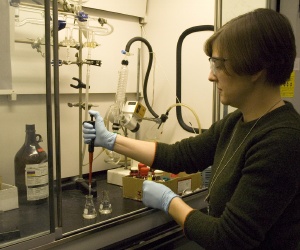Jan 13 2009
The ability of biomolecules to flex and bend is important for the performance of many functions within living cells. However, researchers interested in how biomolecules such as amino acids and proteins function have long had to make inferences from a series of X-ray-like "still pictures" of pure crystalline samples. Now, using a new technique based on terahertz (THz) spectroscopy, scientists at the National Institute of Standards and Technology (NIST) have recently taken the first step toward revealing the hidden machinations of biomolecules in water.*
 NIST researcher Ted Heilweil, National Research Council postdoctoral fellow Catherine Cooksey (pictured), and NIST Summer Undergraduate Research Fellow Ben Greer from Carnegie Mellon University have demonstrated the feasibility of a new technique for studying biomolecules using terahertz radiation. Because terahertz waves are almost completely absorbed by water, the team was able to reduce the amount of water to the bare minimum while still providing a realistic sample environment by using hollow, nanosized droplets called micelles as tiny test tubes. Source: NIST
NIST researcher Ted Heilweil, National Research Council postdoctoral fellow Catherine Cooksey (pictured), and NIST Summer Undergraduate Research Fellow Ben Greer from Carnegie Mellon University have demonstrated the feasibility of a new technique for studying biomolecules using terahertz radiation. Because terahertz waves are almost completely absorbed by water, the team was able to reduce the amount of water to the bare minimum while still providing a realistic sample environment by using hollow, nanosized droplets called micelles as tiny test tubes. Source: NIST
With wavelengths that range from 1 millimeter to 25 micrometers, terahertz radiation falls between the infrared and microwave spectral regions. Researchers can determine how molecules are moving by passing terahertz radiation through a sample and measuring which wavelengths are absorbed. Unfortunately, room temperature water, the medium in which biological molecules typically are studied, absorbs nearly all of the terahertz radiation, limiting the utility of terahertz spectroscopy for probing biomolecular function.
To avoid the water problem, the NIST team needed to find a way to provide a simple but realistic environment for the biomolecules that contained the least amount of water possible. NIST researcher Ted Heilweil, National Research Council postdoctoral fellow Catherine Cooksey and NIST Summer Undergraduate Research Fellow Ben Greer from Carnegie Mellon University found their solution in the form of nanoscale droplets made of soap-like molecules called micelles.
Using the micelles as tiny test tubes, the team filled the hollow molecules with a small sample of water and the amino acid L-proline, a protein building block. Measurements validated their hypothesis that the micelles would provide an aqueous environment that allows the amino acid to flex and bend while limiting the absorption of the terahertz radiation by water. The terahertz measurements on this simple biomolecule compared well with expectations from other studies, further validating the technique.
According to Heilweil, this study is an important first step toward using terahertz radiation for studying biomolecules. More ambitious measurements on larger molecules such as small peptides, proteins, and DNA fragments will be more challenging, but he says it may be possible in the near future.
“If we can get larger molecules in [the micelles], we can get a much better idea of how living molecules function,” Heilweil said. “This will let us see the basic, most fundamental building blocks of life as they move, which is very exciting.”
* C. Cooksey, B. J. Greer and E. J. Heilweil. Terahertz spectroscopy of l-proline in reverse aqueous micelles. Chemical Physics Letters. Available online Nov. 21, 2008.